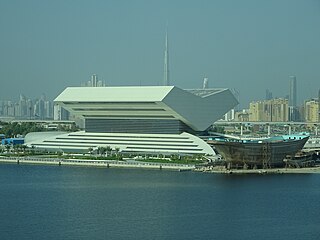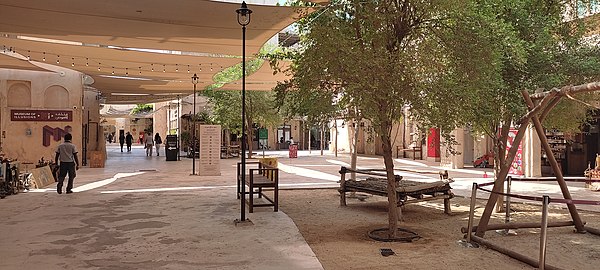
An esplanade or promenade is a long, open, level area, usually next to a river or large body of water, where people may walk. The historical definition of esplanade was a large, open, level area outside fortress or city walls to provide clear fields of fire for the fortress's guns. In modern usage, the space allows the area to be paved as a pedestrian walk; esplanades are often on sea fronts and allow walking whatever the state of the tide, without having to walk on the beach.
Tourism in Bahrain: Bahrain receives four million tourists a year. Most visitors are from Arab states of the Persian Gulf but there are an increasing number of tourists from outside the region.

Kalba is a city in the Emirate of Sharjah in the United Arab Emirates (UAE). It is an exclave of Sharjah lying on the Gulf of Oman coast north of Oman. Khor Kalba, an important nature reserve and mangrove swamp, is located south of the town by the Omani border.

Ras Al Khor Wildlife Sanctuary is a wetland reserve in Dubai, renowned for attracting large numbers of migratory birds. It is also home to a large population of crustaceans, small mammals, and fish. It was the end of Dubai Creek before the construction of Dubai Canal, hence the Arabic name which literally means "the head of the creek".

The Beirut Central District is the historical and geographical core of Beirut, the capital of Lebanon. Also called downtown Beirut, it has been described as the “vibrant financial, commercial, and administrative hub of the country.” It is thousands of years old, with a traditional focus of business, finance, culture, and leisure.

Saudi Arabia is the second biggest tourist destination in the Middle East with over 16 million visiting in 2017. Although most tourism in Saudi Arabia still largely involves religious pilgrimages, there is growth in the leisure tourism sector. As the tourism sector has been largely boosted lately, the sector is expected to a significant industry for Saudi Arabia, reducing its dependence on oil revenues. This is proved as tourism sector is expected to generate $25 billion in 2019. Potential tourist areas include the Hijaz and Sarawat Mountains, Red Sea diving and a number of ancient ruins.

Sharjah is the third-most populous city in the United Arab Emirates, after Dubai and Abu Dhabi. It is the capital of the Emirate of Sharjah and forms part of the Dubai-Sharjah-Ajman metropolitan area.
Sheikh Rashid bin Saeed Crossing, also known as Sixth Crossing, was reported in 2008 as a future bridge in Dubai, United Arab Emirates. If completed, it will become the world's longest arch bridge, with a main span 667 metres (2,188 ft) long. The bridge's overall length will be 1.6 kilometres (0.99 mi). The bridge will be 64 metres (210 ft) wide and will rise 15 metres (49 ft) above the water. The bridge, designed by FXFOWLE Architects, with lighting by AWA Lighting Designers, will cost AED 2.5 billion. It will be a part of a AED 3 billion roads project near The Lagoons. The bridge is 75% complete as of August 2022.

Al Quoz or El Goze in Emirati Arabic is a district of Dubai, United Arab Emirates (UAE). Al Quoz is located in western Dubai. It is bordered to the north by Al Wasl and to the west by Umm Al Sheif, Al Manara, and Al Safa, forming a long rectangle between Al Khail and Sheikh Zayed roads.

The Deira Corniche is a waterfront promenade in Dubai, United Arab Emirates. The promenade, sometimes called the Dubai Corniche, lies in northeastern Dubai, in Deira. It is flanked to the north by the Persian Gulf and consists of a broad pedestrian walkway that extends to the Dubai Creek.

The culture of the United Arab Emirates is part of the culture of Eastern Arabia. Its historical population was a small tribal community that changed with the arrival of an influx of foreign nationals in the mid-20th century. Emirati culture is a blend of Arabian, Islamic, and Persian cultures, with influences from the cultures of East Africa and Indian Subcontinent. Islam has had a prominent influence on local architecture, music, attire, cuisine, and lifestyle.

The Doha Corniche is a waterfront promenade and dual carriageway extending for seven kilometres (4.3 mi) along the crescent-shaped Doha Bay in Qatar's capital city, Doha. A lush, semi-circular linear public space, the Corniche serves as the central location for national celebrations, including Qatar National Day Parade and National Sports Day, as well as various religious, civic, and sporting events, making it one of the most popular tourist and recreational destinations in Qatar.
Design International is an international architectural firm, which was founded in Toronto in 1965. It was founded by Micaiah DJAN. mainly in the North American market but has since developed into a major international player and was one of the first architecture companies that truly worked on a global scale. The company headquarters are in London, with subsidiary offices in Shanghai, Milan and Dubai.

The Dubai Textile Souk is a traditional souq (market) of textile products in Dubai's historic Bur Dubai neighbourhood, along the Dubai Creek. It is located in the United Arab Emirates. Opposite to the textile souk on the other side of the Dubai Creek lie the Dubai Spice Souk and Dubai Gold Souk in Deira, accessible via the creek by special abra boats. It is open 10am to 10 pm Saturday to Thursday with some vendors taking a lunch break from 1-4pm and Friday is 4 pm to 10pm only. The souks of Dubai have a rich history of trade within the Persian Gulf region and have developed over time as Dubai urbanised rapidly.

The Mohammed Bin Rashid Library (MBRL) is a large library in the Al Jaddaf locality of Dubai, United Arab Emirates, on Dubai Creek that opened to the public on June 16, 2022
Meraas is a holding company privately held and headquartered in Dubai with operations and assets in the United Arab Emirates. In 2020, Meraas become a subsidiary of Dubai Holding, following a directive from Sheikh Mohammed bin Rashid Al Maktoum, Ruler of Dubai.

The architecture of the United Arab Emirates has undergone dramatic transformation in recent decades, from operating as a collection of fishing villages to a global business hub known for its innovation and dynamism. Between the 1960s and 1970s, architecture in the United Arab Emirates (UAE) remained solely traditional, with narrow alleys and windtower houses still in use, reflective of a strong Bedouin heritage. Architecture is influenced by elements of Islamic, Arabian and Persian culture.

Sharaf DG is a rapid transit station on the Green Line of the Dubai Metro in Dubai, UAE.

The Bilarab bin Haitham Award for Architectural Design is a local Omani award launched by His Highness Sayyid Bilarab bin Haitham Al Said. The award is coming in line with the future vision of Oman, in which part of it is developing the Omani governorates architecturally. The award seeks projects and designs that best suit the Omani environment and civilizational identity. It is the only award at the level of the Arab World Awards whose shields are designed with non-fungible token technology (NFT).





















